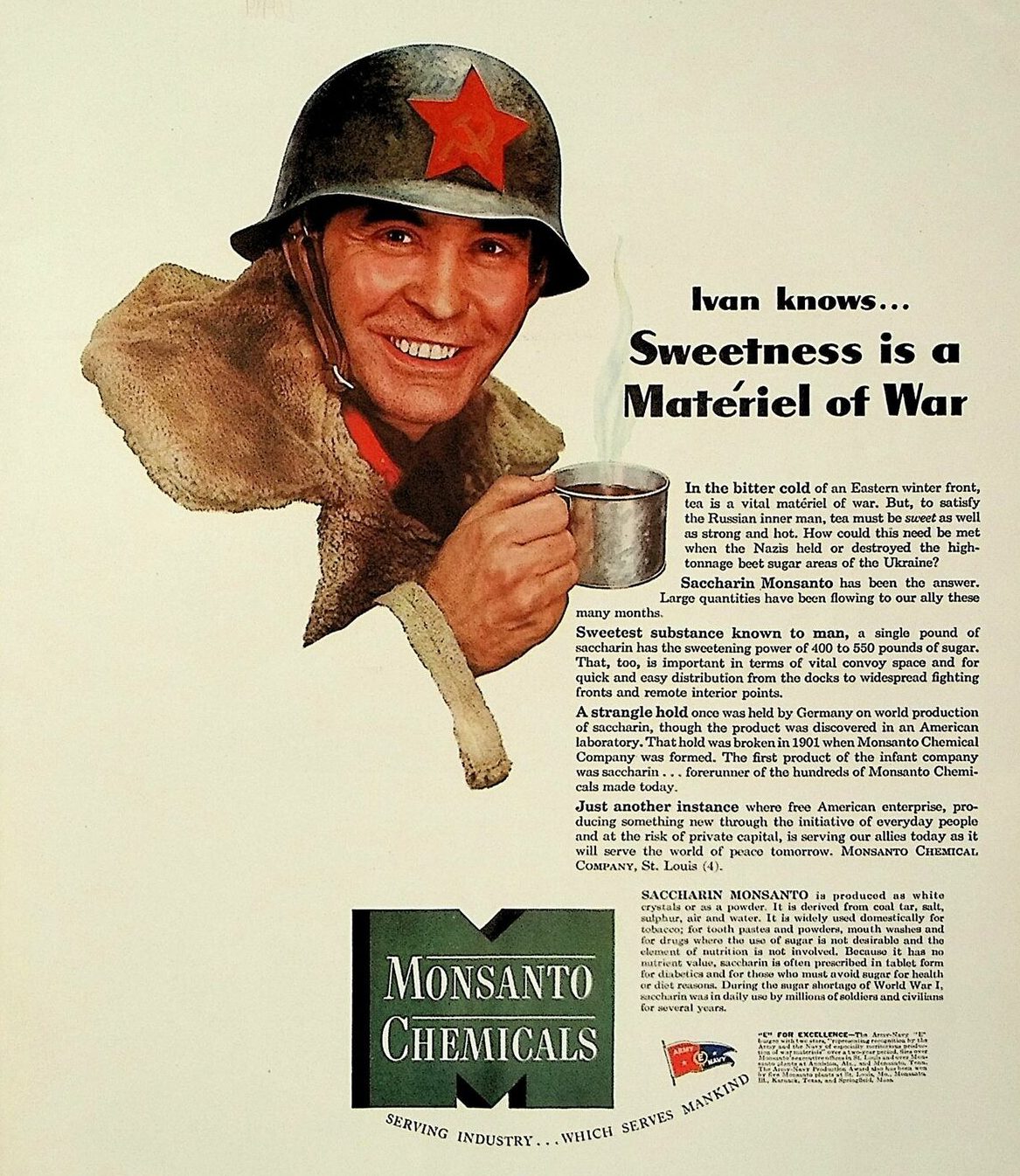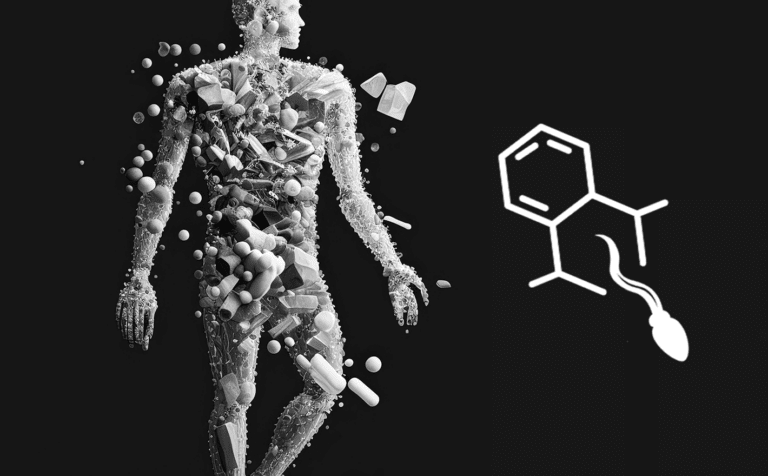Every great villain needs a great origin story.
The majority of people reading this article are undoubtedly aware that artificial sweeteners like saccharin and aspartame are bad news, but how many actually know the tales of how they came to be?
It’s reasonable to expect any account involving Monsanto, the world’s most hated company, or Donald Rumsfeld, the master architect of the 2003 Iraq War, to be filled with intrigue, deception, and all manner of shadiness, and the stories behind these two controversial chemicals are by no means exceptions.
The close proximity of the military-industrial-chemical complex to the rise of artificial sweeteners, and America’s massive cultural shift toward the acceptance of the synthetic, have gone largely gone unnoticed. Once you start to connect the dots, though, it’s hard to un-see it.
According to author Carolyn de la Peña, the practice of consuming synthetic flavor chemicals that provide zero nutrition is suggestive of a deeper imbalance in the modern psyche. In her book (upon which this article is heavily based) “Empty Pleasures, The Story of Artificial Sweeteners from Saccharin to Splenda”, she brilliantly illustrates this collective neurosis, boldly referring to it as a kind of ‘socially acceptable bulimia’:
“We can commit to rigorous exercise routines to burn extra calories. We can make lists of what we do and do not eat…Or we can attempt to buy what we desire but strip those desired foods of their “bad” qualities. This last option is a form of socially acceptable bulimia, a way that the food itself can be “eaten” but not digested. And, thanks to artificial sweeteners, it has been the most popular way of dealing with our national eating disorder over the last fifty years.”
De la Peña paints a grim picture of America’s transition from, at the turn of the 20th century, a nation of folks with a healthy distrust of the unnatural, to—by the time the second world war erupted—a country smitten with better living through chemistry and ready to accept artificial sweeteners as part of a healthy diet, something their predecessors would have found unfathomable.
Saccharin: Monsanto’s First Matériel of War
It may come as a surprise that saccharin was first discovered well over a century ago. Debuting at the World’s Fair in 1893, it was marketed as a ‘perfectly harmless spice’…one that just so happened to be a chemical that does not exist in nature, provides no nutrition, and is derived from industrial coal tar.
In 1901, a man by the name of John Queeney opened the first domestic saccharin production facility. Two years later, he named his company ‘Monsanto Chemical’. In addition to saccharin, Monsanto also began producing synthetic caffeine and synthetic vanillin, two other ingredients essential to the mass production of cheap cola.
At the beginning of the twentieth century, in the era of our great- and great-great-grandparents, most Americans weren’t keen on the addition of synthetic chemicals to their sodas, but Monsanto and the rest of the saccharin cartel had the law on their side. Or, more accurately put, they had the absence of the law on their side.
At the time, companies were not required to label artificial ingredients like saccharin on their soft drinks. In 1911, an anti-saccharin ad from a soda company read, “Did you ever taste saccharin?” before implying that most people already had, but without their knowledge or consent.
Way back then, a century before the rise of keto and the low-carb craze, sugar was not considered the great devil that it is today. On the contrary, it was considered a cheap, efficient way to boost energy and productivity for soldiers and housewives alike.
Bizarrely enough, sugar was even marketed as a weight loss aid for women. One ad even showed a thin, attractive woman licking an ice cream cone with a caption that read, “Sugar can be the willpower you need to under-eat.”
According to de la Peña, as the propaganda war between the sugar industry and Monsanto’s many customers raged on, all attempts to ban saccharin were thwarted, but public attitudes remained largely negative. Although it had gained traction among physicians as a substance that could be helpful to people with diabetes, most folks were still distrustful of it, and who could blame them?
Including a synthetic byproduct of industrial coal tar in your beverages without disclosing it to your customers doesn’t exactly scream transparency.
Saccharin Supports Our Troops
Suddenly, as if by some miracle, attitudes toward saccharin began to shift.
Enter World War II, which massively disrupted supply chains and made sugar increasingly hard to find. Ask anyone who was alive back then, and they’ll tell you: it was a time when many things that were once plentiful and taken for granted were suddenly subject to intense rationing.
In a cookbook called “War Time Meals”, the author asked, “Are you sure that you really need two large lumps in your breakfast coffee, or are you just thoughtlessly following a long-established habit?”
De la Peña suggests that saccharin’s reputation was revised purely out of necessity. In a world where sugar was becoming increasingly scarce, a controversial chemical alternative suddenly seemed appealing.
“You don’t expect me to drink this coffee black, do you?” screamed the masses who could no longer afford to pay exorbitant wartime prices for sugar. “Not at all,” replied Monsanto. “We’ve got you covered.”
De la Peña also cites a 1940 New York Times article as evidence of a major turning point. In it, the author claims that saccharin went from “medically branded a poison, so that even diabetics were afraid of it” to an ingredient whose “curse is removed.” Shortly after, the Cornell University School of Nutrition distributed a pamphlet announcing that saccharin was perfectly safe, even for healthy people.
Long before they earned the moniker ‘Monsatan’ for some of their greatest hits, such as 2,4-D (used in Agent Orange), DDT, Roundup (AKA glyphosate), or GMO seeds, Monsanto was well into producing a cornucopia of death chemicals when World War II erupted. In addition to making PCBs and polystyrene (used in styrofoam), they were also manufacturing ammunition, metals, and plastics needed by the US Military.
Check out this ad featuring Ivan, a Russian soldier with an absurdly wide grin for someone whose comrades are literally dying by the millions.
Why is Ivan so happy? He’s rejoicing because, even though the Nazis destroyed the sugar beet crops in Ukraine, Monsanto’s miracle chemical, saccharin, can still provide him with a piping hot cup of the ‘vital matériel of war’ known as SWEET TEA!

In another whimsical wartime Monsanto ad, the chemical giant posed the all-important question, “How much chemistry per soldier?”

Monsanto Purchased by Notorious Nazi Pharmaceutical Company
The companies that make up the military-industrial-chemical complex are particularly incestuous. It’s especially ironic that Monsanto, which prided itself on helping the allied forces fight Hitler, was eventually purchased for over $60 billion by one of the most notorious Nazi companies of all time.
Just a few years ago, Monsanto was purchased by Bayer (formerly IG Farben), the German pharmaceutical company that boasts such great accomplishments as:
- Inventing heroin (and marketing it as a cure for morphine addiction)
- Being the largest contributor to Hitler’s election campaign
- Producing the pesticide Zyklon B, which was used in Nazi gas chambers
- Purchasing humans from the Nazis for forced (and often lethal) pharmaceutical research
The relationship between saccharin and the global war machine should already raise some eyebrows, but as we’ll see in the next section, it’s not the only example.
Unknown Unknowns: the Shady Story of How Donald Rumsfeld Got Aspartame Approved
In 1969, at the beginning of the Nixon administration and the height of the Vietnam war, the FDA banned saccharin’s only competitor, cyclamate (which is still legal in over 130 countries), over concerns that it was a carcinogen. Monsanto and other producers of saccharin were officially spooked.
Four years prior, a chemist working at GD Searle pharmaceuticals accidentally discovered the molecule that would later be known as aspartame. Much to Searle’s delight, it was significantly more palatable than saccharin, with less of a bitter aftertaste.
By 1977, the FDA was openly discussing a ban on saccharin. Searle had already begun working overtime to ensure that aspartame would be ready to swiftly replace it, funding hundreds of safety studies. That’s when they brought in none other than Donald Rumsfeld as their CEO, and attorney Robert Shapiro as their president (if that name sounds familiar to you, it’s because Shapiro was part of the ‘Dream Team’ that defended OJ Simpson and also worked with the Menendez Brothers, who were convicted of murdering their parents in the 90s).
Though many are familiar with Rumsfeld’s role as Secretary of Defense and architect of the second Iraq War during the presidency of George W. Bush, few people know that he had already occupied that same position during the Ford administration. Perhaps Searle foresaw that Rummy’s connections at the White House might somehow prove useful?
In 1980, an FDA Board of Inquiry on aspartame decided that, based on available evidence, aspartame may induce brain tumors. Rumsfeld’s fledgling Franken-molecule was in danger of a permanent ban, but he had one last trick up his sleeve. He is rumored at the time to have made the statement that he would “call in his markers”.
And call them in he did.
Rumsfeld Helps Pick the New FDA Commissioner
In January of 1981, Ronald Reagan was sworn into office, and Rumsfeld–still Searle’s CEO–was brought in as part of the transition team that got to pick the new FDA commissioner, Dr. Arthur Hayes, Jr.
Hayes immediately appointed a group of five scientists to review the previous Board of Inquiry’s decision. They voted 3 to 2 to continue the ban on aspartame, based on concerns that it was likely carcinogenic.
Then, in an act that smacks of desperation, Hayes added a sixth member to the team, who tied up the vote at 3-3, then installed himself as the seventh member of the team, breaking the tie in favor of aspartame. In July of 1981, just a few months into his new position, he officially approved the use of aspartame in food. Hayes then suddenly resigned just two years later, after having been accused of accepting money from some of the very corporations he was supposed to be regulating.
Perhaps he had completed his sole mission, the reason for his installment as head of the FDA, and it was simply time to move back into the private sector to make some serious cash? Or maybe his thumb, with so much time pressed against the scale, just needed a little time to recover.
Shortly after Hayes left the FDA, he coincidentally landed a position as a senior medical advisor for Burson-Marsteller, a company that both Monsanto and Searle just so happened to use as their primary public relations firm. It’s clear that this has nothing to do with his approval of aspartame during his brief stint as head of the FDA, though.
And as for our friend saccharin, things ended up turning out alright…kind of. It was never banned, but aspartame became the dominant sweetener, with much of the public having no idea just how many strings were pulled–and how many studies ignored–to force it through the approval process.
Wikileaks Releases Emails From Previous Head of FDA on Rumsfeld and Aspartame
In 2013, Wikileaks released some emails between Donald Kennedy (who headed the FDA in the late 1970s shortly before Rumsfeld put Dr. Hayes in) and Wendy Abrams, who lead a non-profit that was concerned with the addition of aspartame to chocolate milk marketed to children. Kennedy expressed concern, and suggested that she reach out to the FDA, saying “I think it is a big deal.”
Interestingly, Kennedy was only FDA commissioner for two years, from 1977-1979. He left suddenly, leaving many to speculate that his attempts to ban saccharin and negative opinion of aspartame may have been at play.
Kennedy mentioned in the email that he met with Rumsfeld when he was FDA commissioner, and referenced the story of how aspartame was eventually approved by his successor (in a not-so-positive light). He then told Abrams, “Rumsfeld has a lot to answer for in his next life.”
It’s worth noting that Rumsfeld also facilitated the purchase of Searle’s Nutrasweet Subsidiary by–you guessed it–Monsanto, bringing us full circle.
If Rumsfeld is anything, he’s a master salesman. He sold the American public the second Iraq War, one of the greatest military mistakes in history, sold the FDA on aspartame, and even helped sell Nutrasweet to Monsanto.
The TL;DR Version
If you’ve already read the rest of the article, here’s a nice review of all the main points. If you skipped here directly from the introdution, then enjoy this quick summary, and consider going back to read both sagas, as they’re thoroughly fascinating.
Monsanto and Saccharin:
- Monsanto’s first product was Saccharin (early 1900s)
- Saccharin remained fairly unpopular, but is put into soda without peoples’ knowledge, angering many (1900s – 1930s)
- Various attempts to ban it are unsuccessful. It benefits from recognition as a helpful sugar alternative for diabetics. (1900s – 1930s)
- When World War II hits, sugar is increasingly rare, and its ‘curse’ is magically lifted out of necessity
- Monsanto, already making ammunition and many products needed by the military, advertises saccharin as a ‘matériel of war’ (see graphic in previous section)
- In 2018, Monsanto is purchased by Bayer (formally IG Farben), a notorious Nazi pharmaceutical and chemical company who made the poisons used in the gas chambers, used concentration camp inmates as lab rats, was a top contributor to Hitler’s election campaign, and invented heroin
Rumsfeld and Aspartame:
- Aspartame is discovered by a chemist at GD Searle pharmaceuticals (1960s)
- Searle installs Donald Rumsfeld, who was already Secretary of Defense under Gerald Ford, as their CEO (late 1970s)
- An FDA board of inquiry on aspartame votes against its approval, claiming that it ‘might induce brain tumors’ (1980)
- Rumsfeld is brought onto Reagan’s transition team and helps pick the new FDA commissioner, Dr. Arthur Hayes, Jr. (1981)
- Hayes bends over backwards to get aspartame approved, overturning the FDA’s previous decision to keep it out of the food supply
- Hayes resigns two years later (under allegations of impropriety), then takes a position with Searle and Monsanto’s PR Company, Burson-Marsteller
- Rumsfeld facilitates the purchase of Searle’s Nutrasweet subsidiary by Monsanto (1985)
- A Wikileaks email from the previous head of the FDA Donald Kennedy (1977-1979), who fought against saccharin and aspartame, quotes him as saying, “Rumsfeld has a lot to answer for in his next life.”
- Two decades after selling the public on aspartame, Rummy goes on to sell the American public on one of the greatest military mistakes in history, the 2003 Iraq War
Still Thirsty For Knowledge?
Here in CHOQ Nation, we love to educate people about the pervasive chemicals that threaten our health, and we do our best to provide folks with natural solutions to maintain their vitality amidst all the toxicity.
We also use full-disclosure labeling, and have impeccable quality standards that prevent the use of all artificial sweeteners, flavors, dyes, and preservatives. In fact, we don’t even use so-called ‘natural flavors’, which are decidedly less natural than you might think.
If you’d like to learn more about the toxic soup we live in, and how to protect yourself from it, check out these articles:





